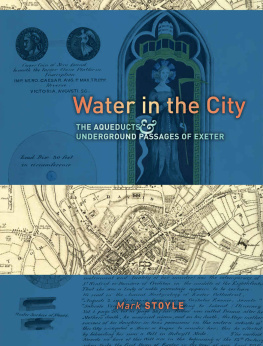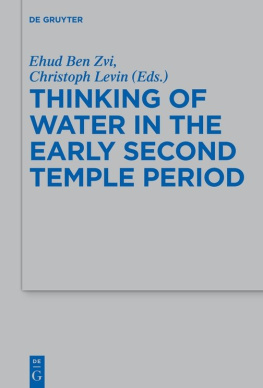WATER IN THE CITY
The network of underground passages which snakes its way beneath the city of Exeter is a unique historic monument: a system of subterranean aqueduct tunnels which still stands as vivid testament to the skill and ingenuity of the medieval craftsmen who built it, and which cannot be paralleled anywhere else in Britain. Water in the City provides a richly illustrated history of Exeters famous underground passagesand of Exeters highly sophisticated system of public water supply during the medieval and early modern periods.
The books reliance on both documentary and material evidence ensures a solid foundation of scholarship, while its ability to tell such an interesting tale of urban technology in terms of its impact on humans will appeal to a large audience at home and abroad.
Maryanne Kowaleski, Professor of History at Fordham University, New York
Professor Stoyles important new study of the water supply of Exeter offers the fullest account of the development of such provision in any town in Britain, charting the construction of a steadily more complex system of piped water supplies from its origins in the late twelfth century to the early nineteenth. Written in an accessible and vivid style and handsomely illustrated, the study will be equally enjoyable to the specialist and the general reader.
John Allan, Exeter Cathedral Archaeologist
This unusual book is a very fine piece of scholarship that is also extremely clear, interesting, and easy to read.
Martha Carlin, Professor of History at University of Wisconsin-Milwaukee
Mark Stoyle is Professor of early modern History at the University of Southampton
WATER IN THE CITY
THE AQUEDUCTS AND UNDERGROUND PASSAGES OF EXETER
Mark Stoyle
UNIVERSITY of EXETER PRESS
First published in 2014 by University of Exeter Press
Reed Hall, Streatham Drive
Exeter EX4 4QR
UK
www.exeterpress.co.uk
2014 Mark Stoyle
The right of Mark Stoyle to be identified as author of this work has been asserted by him in accordance with the Copyright, Designs and Patents Act 1988.
British Library Cataloguing in Publication Data
A catalogue record for this book is available from the British Library.
ISBN 978 0 85989 877 5
Typeset in 11.5pt Baskerville by Carnegie Book Production, Lancaster
Printed in Great Britain by Short Run Press Ltd, Exeter
This book is dedicated to the memory of my grandfather, Freddie Stoyle, formerly of Foggintor, Dartmoor
19132009
Shall I search the under-ground, Where all Damps, and Mists are found?
Robert Herrick, Hesperides (1648).
CONTENTS
ILLUSTRATIONS
Maps
- Exeters aqueducts in c.1200
- Exeters aqueducts in c. 1270
- Exeters aqueducts and underground passages in 1350
- Exeters aqueducts and underground passages in 1400
- Exeters aqueducts and underground passages in 1430
- Exeters aqueducts and underground passages in 1450
- Exeters aqueducts and underground passages in 1502
- Exeters aqueducts and underground passages in 1570
- Exeters aqueducts and underground passages in 1700
- Exeters aqueducts and underground passages in 1836
All maps drawn by T. Ives, Exeter Archaeology
Figures
- The entrance to the underground passages, 2011
Photograph: G. Young, Exeter Archaeology
- Well Street in 2011
Photographs: G. Young, Exeter Archaeology
- Exeter in c.1300
Drawn by T. Ives, Exeter Archaeology
- Reconstruction of St Nicholas Priory
Drawn by R. Parker, Exeter Archaeology
- Map of Exeter dated 1618
Courtesy of the RAM Museum, Exeter
- The water supply in early medieval tenements
Exeter Archaeology
- Plan of the Underground Passages, 1931
Courtesy of the Devon Archaeological Society
- The area around East Gate before and after the Blitz
Photographs by Airpic
- Survey work in the underground passages, c.1990
Exeter Archaeology
- Fragments of marble from the lavatorium at St Nicholas Priory
Photographs: D. Garner
- Reconstruction of the lavatorium at St Nicholas Priory, c.1180
Drawing by R. Parker, Exeter Archaeology
- St Sidwells well
Courtesy of the Dean and Chapter of Exeter Cathedral and the Devon Record Office
- St Sidwell, from the great east window of Exeter cathedral, c.1391
Photograph: C. Brooks
- Archaeological excavations at King William Street, 1983
Exeter Archaeology
- Archaeological excavations near the eastern angle tower, 200506
Exeter Archaeology
- Map showing the course of the first cathedral aqueduct
Prepared by J. Allan/T. Ives, Exeter Archaeology
- The point of entry of the first cathedral aqueduct
Photographs: G. Young. Courtesy of the RAM Museum and Exeter Guildhall
- Views of St Peters fountain
Courtesy of the Dean and Chapter of Exeter Cathedral and the Devon Record Office
- The location of the original Black Friars conduit-head
Courtesy of the Devon Record Office and Her Majestys Stationery Office
- The chamber built to carry the pipe of the thirteenth-century Black Friars aqueduct through the city wall
Sketch: A.W. Everett. Courtesy of the Devon Record Office
- Reconstruction of the probable course of the thirteenth-century aqueduct passing through the city defences
Prepared by J. Allan/T. Ives, Exeter Archaeology
- The Exeter cathedral fabric roll and the west front of the cathedral
Photographs: G. Young. Courtesy of the Dean and Chapter of Exeter Cathedral
- Section of the cathedral conduit-house at Headwell
Photograph: G. Young. Courtesy of the Dean and Chapter of Exeter Cathedral
- The course of the fourteenth-century cathedral aqueduct between Headwell and Longbrook Street
Photograph: G. Young. Courtesy of the Devon Record Office
- Plan of the fourteenth-century cathedral aqueduct passing through the city walls
Map drawn by T. Ives, Exeter Archaeology
- Views of the fourteenth-century cathedral passage
Photograph: G. Young, Exeter Archaeology
- The fourteenth-century cathedral passage
Photograph: G. Young. Courtesy of the Devon Archaeological Society
- The original man-hole in the garden of St Johns Hospital
Photograph: G. Young. Courtesy of the Devon Archaeological Society
- The vaulted section of the fourteenth-century cathedral passage
Photographs: G. Young, Exeter Archaeology
- Possible suspiral shafts incorporated in the fourteenth-century cathedral passage
Photographs: G. Young. Elevation prepared by Exeter Archaeology
- The location of the main city and cathedral conduit-heads, 1836
Photograph: G. Young. Courtesy of the Devon Record Office
- The adit supplying the city conduit-head at Cake Lane well, 1785
Photograph: G. Young. Courtesy of the Devon Record Office
- The fifteenth-century city conduit-head at Cake Lane well, 1836
Photograph: G. Young. Courtesy of the Devon Record Office
- Longbrook Street, 2011
Photograph: G. Young. Exeter Archaeology
- St Stephens church, early 2000s
Photograph: D. Garner, Exeter Archaeology
- The pipeline from the higher well to Cake Lane well, 1836
Photograph: G. Young. Courtesy of the Devon Record Office
- Possible suspiral shaft at the summit of the city aqueduct, 1836
Photograph: G. Young. Courtesy of the Devon Record Office
- Reconstructed section and plan of the pipe-bridge carrying the fifteenth-century city aqueduct
Drawn by T. Ives, Exeter Archaeology
- The chamber built to carry the pipe of the fifteenth-century city aqueduct through the outer abutment of East Gate-bridge
Next page









